Buying a Commercial Property that has a Well: 7 FAQs
Have you identified a commercial property for purchase but are concerned because it has a potable water well? If so, welcome to the club!
Most commercial or industrial properties are connected to public water supplies but it is not that uncommon to find sites served by wells. In some areas, municipal water supply infrastructure has just not kept up with the pace of development.
The presence of a well is not necessarily a deal killer but it does necessitate additional due diligence and precautions. The answers to frequently asked questions about the additional due diligence necessary prior to acquisition of properties that have potable water wells are presented below:
- What are the risks associated with a private well?
The biggest risk in purchasing a commercial property served by a potable well is that the water supply is contaminated. A contaminated water supply would certainly be detrimental to the value of the property and, depending upon the degree of contamination, the well may be unfit for human consumption even after treatment.
If the water supply was contaminated due to previous activity on the property, the liability transferred to the purchaser could be more than the value of the property itself! See: Environmental Risks for Property Buyers.
Another risk is that the well may not be able to provide a sufficient quantity of water necessary to utilize the property in the intended manner. Well depth, seasonal water table fluctuations, and well production rates should be investigated.
- What types of contaminants should I be worried about?
Well owners should be concerned with three types of contamination.
- Natural
- Biological
- Chemical
Natural
Naturally occurring contaminants include potentially hazardous elements such as arsenic, radon and uranium which are derived from certain source rocks and dissolved in groundwater. The presence of these chemicals is of greater risk in particular areas of the country.
Certain rock types can also be a source of contaminants that, while not hazardous, could be in concentrations that would make the water unpalatable (i.e., iron and sulphur).
Biological
The presence of microorganisms including bacteria, parasites and viruses could impact water quality. The most common types of microorganisms encountered in well water are Coliform Bacteria. This type of contamination is typically derived from the influx of surface water, septic systems or agricultural runoff.
Chemical
Chemical contaminants include a wide array of chemical compounds, including nitrates or pesticides from agricultural runoff, volatile organic compounds, heavy metals and solvents from industrial and fuel related sources and organic chemicals from dumping or household related sources.
- What types of testing should I perform?
The short answer here is it depends. At a minimum, all wells should be tested for pH and Total Coliform.
The pH level of the water can change how well water looks and tastes. If the pH of is too low or too high, it could damage pipes and cause heavy metals like lead to leak out of the pipes into the water.
Total Coliform is an indicator test. These microbes typically do not make a person sick; however, because microbes that cause disease are difficult to test for in water, “Total Coliforms” are tested instead. If the Total Coliform count is high, then it is very possible that harmful germs like viruses, bacteria, and parasites might also be found in the water.
Other testing should be conducted based upon the regional geology, whether the property is in a rural or urban environment, what type of business is on the property, what type of businesses used to be on the property and what type of businesses are in the surrounding area. This information is typically provided in a Phase 1 Environmental Site Assessment (Phase 1 ESA).
EPA provides this Quick Reference Table as a checklist to identify activities and types of sources to identify potential contaminants in the environment that may impact drinking water wells.
| Activity Type | Potential Well Contaminant Sources |
| Agriculture | Fertilizer storage and use, animal feedlots, animal waste disposal systems, animal burial, manure stockpiles (e.g. pits and lagoons), manure spreading, general waste disposal wells, pesticide storage and use (e.g. spread by airplane), field irrigation |
| Commercial | Airports, boatyards, railroad track and yards, junkyards, recycling and waste transfer stations, auto repairs shops, carwashes, laundromats, dry cleaners, paint shops, gas stations, construction sites, golf courses, floor drains and waste disposal wells, research laboratories and medical institutions, funeral homes and cemeteries |
| Industry | Oil and gas production and storage, pipelines, petroleum refineries, chemical manufacture and storage, mining, electroplating facilities, foundries, metal fabrication facilities, machine shops, waste disposal wells, paper mills, textile mills |
| Residential | Fuel oil storage tanks, household chemical storage and use, swimming pool chemical storage, septic tanks and leach fields, sewer lines, floor drains, lawn fertilizer storage and use |
| Other | Road de-icing, landfills, sewer lines, storm water pipes and drains, abandoned production and disposal wells, nearby active disposal wells, illegal dumping |
- Can I sample the well myself?
Certain types of testing (bacteria, hardness, pH, etc.) may be provided by the local Health Department. However, specialized testing requires specific methods depending upon the type of analysis, chemical specific sampling procedures, bottle requirements, sample preservation methods and chain of custody protocols.
Specialized analyses are beyond the scope of a local health department and require the services of a contract laboratory and a specifically trained sample technician.
- The laboratory results indicate the presence of contaminants. Is that a deal killer?|
When this happens, and you really want the property, it is time to conduct a Phase II Environmental Site Assessment (Phase 2 ESA) to determine your risks and what it will take to provide a source of potable water to the property..
The most important thing to keep in mind is that a property owner may be liable for the contamination regardless of whether he or she caused the contamination. However, if the contamination is limited and can be cleaned up for a reasonable cost, remediation may greatly enhance the value of the property.
- Is the well regulated by the EPA?
No. EPA does not regulate private wells nor does it provide recommended criteria or standards for individual wells. However, depending upon how the well is used (i.e. Industrial use or food service) other agencies may have applicable regulations and permitting. In most cases the well is not regulated.
The bottom line is, private well owners are responsible for the safety of their water.
- If there is public water available, should I keep the potable well?
In most cases, and if it is convenient and easily accessible, I recommend businesses connect to the public water supply. Public water supplies are usually treated and tested regularly so it takes the worry out of providing potable drinking water.
If the property has irrigation needs, by all means utilize the “free” water for irrigation. If there is no use for the well, then have it properly abandoned. Deteriorating well materials can provide a means for surface runoff to contaminate groundwater. By eliminating a potential contaminant pathway, we lower the risk of contaminating the water supply.
After reading the FAQs are you overwhelmed? Consider this: our corporate Headquarters is served by a well. Below is the background of the property and the decisions we made to ensure a safe water supply and a good real estate investment.
Property History
The area where the property is located was formerly residential/agricultural. It is currently served by public sewer and a potable well. The regional geology is limestone.
There is public water nearby, but it is located across a 5-lane highway in one direction and over a thousand feet down a road and across another street in the other direction.
The property history was residential until it was re-developed and occupied by a metal fabrication business. The surrounding area was formerly agricultural and over the last 30 years was developed into a light industrial park.
Observations
- Connection to the public water supply line is not a cost-effective option.
- This source rock is not known for containing naturally occurring contaminants but it is a highly transmissive aquifer in a sinkhole prone area. Thus, it has the potential for impact by surface related contaminants.
- The presence of a large roadway and the use of salt for surface treatment in winter provides a potential for salinity impact to the groundwater supply.
- There is a historical presence of septic fields serving previous and nearby residential properties.
- There is a potential impact from historical agricultural runoff. (Mostly related to corn and soybean farming.)
- There is a potential for impact from organic solvents and heavy metal use at the metal fabrication business.
Analytical Testing
We conducted the following analyses:
- Total Coliform, pH and salinity. Reason: Investigate potential surface related contaminants, roadway treatments, septic leach field and agricultural runoff.
- Nitrates, herbicides and pesticides. Reason: Investigate possible contamination from agricultural runoff.
- Volatiles, semi-volatiles and heavy metals. Reason: Investigate potential contamination related to spills of solvents or oil related materials from the metal fabricating business.
Results and Actions
All of the indicator parameters and chemical concentrations fell within drinking water guidelines. As an additional precaution related to potential bacterial contamination should surface runoff or flooding become a problem in the future, we decided to take the extra measure of installing an ultraviolet (U/V) system. The U/V system is designed to mitigate the potential for bacterial issues.
The moral of the story here is know the issues in the area, conduct proper testing and be safe.


